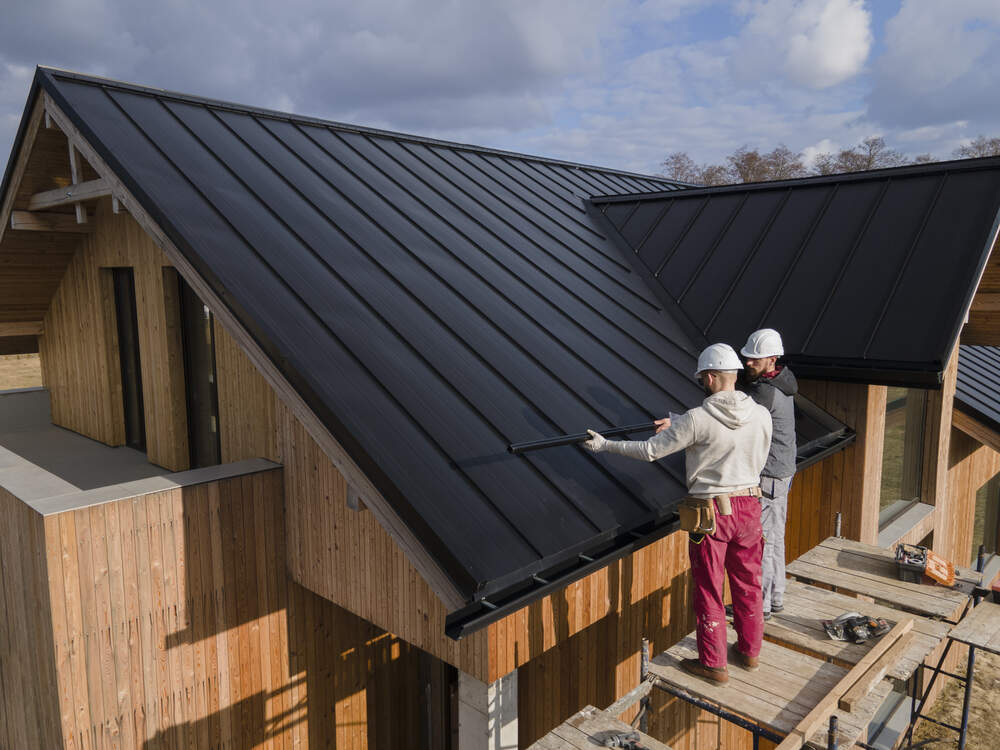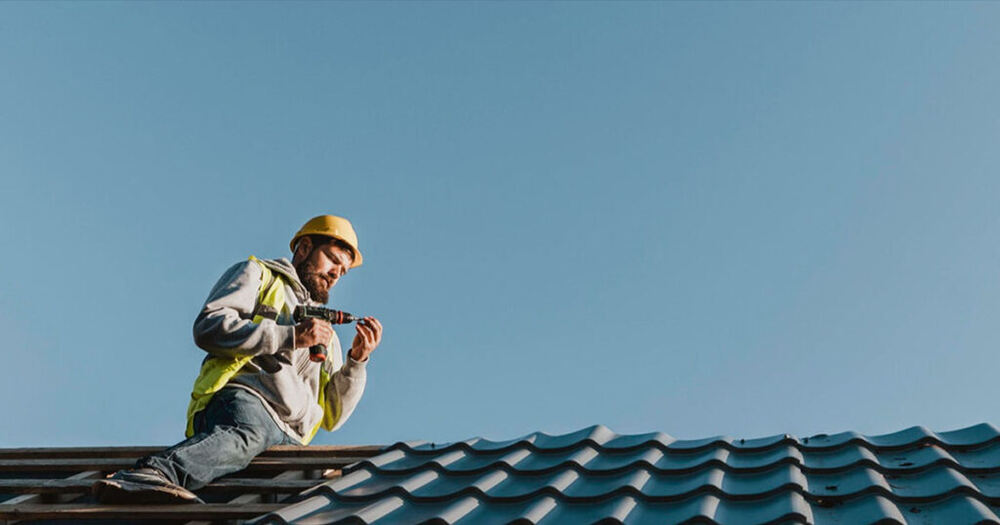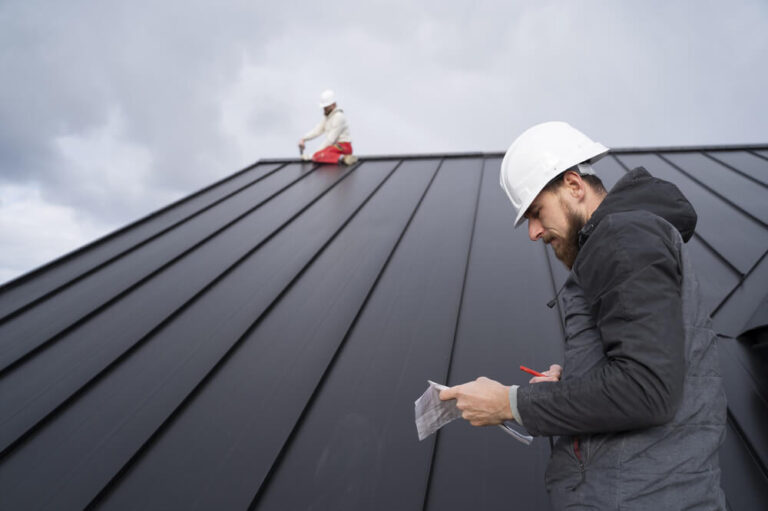- Free Estimates

A well-maintained roof is essential for protecting a home from the elements, ensuring energy efficiency, and preserving property value. However, homeowners often face a dilemma when their roof sustains damage—should they opt for roofing repair or a full roofing replacement? Understanding the factors involved in this decision can help homeowners make the right choice, saving both time and money.
Here are the key considerations when choosing between roof repair vs replacement, covering cost analysis, environmental impact, and professional roof damage assessment to help homeowners understand how to handle emergency roof repair and whether a minor fix or a full roof overhaul is the best solution.
Key Takeaways✔ Small, contained issues like missing shingles or minor flashing problems can often be fixed without a full replacement. ✔ If a full roofing replacement is too costly, targeted roofing repair can extend the roof’s life until a larger investment is feasible. ✔ Homeowners planning to sell soon can benefit from minor roofing repair instead of replacing the entire roof. ✔ Temporary repairs can protect the home after a storm until more comprehensive solutions can be implemented. ✔ If an insurance policy only covers partial damage, roofing repair may be the more practical financial choice. ✔ If more than 30% of the roof is damaged, roofing replacement is more cost-effective than repeated repairs. ✔ Sagging, water damage, or rotting support beams require a full roofing replacement to prevent further hazards. ✔ Upgrading to modern materials can lower utility costs and improve insulation over time. ✔ A new roof enhances curb appeal and can significantly increase property value, making it a worthwhile investment. ✔ Homes in storm-prone areas benefit from impact-resistant roofing materials that provide long-term durability. |
Before deciding between roofing repair and roofing replacement, it is crucial to evaluate the current state of the roof. A roof damage assessment conducted by a professional can provide a clear picture of whether repairs will suffice or if a replacement is inevitable.
The age of a roof is a major determinant in the decision-making process. Different roofing materials have varying lifespans:
The severity of the damage significantly influences whether roofing repair is a viable option. Some common roof issues include:
If a roof requires frequent emergency roof repair, homeowners should consider the long-term costs of repeated fixes. Continual patchwork may end up being more expensive than investing in a full roofing replacement.

There are certain situations where roofing repair is the most practical solution. Not every roofing issue requires a full roofing replacement, and in many cases, simple fixes can restore functionality and extend the roof’s lifespan.
When roof damage is limited to a small area, roofing repair is the most cost-effective option. This includes:
In these cases, a targeted emergency roof repair can restore the roof’s function without requiring extensive work. Acting quickly can also prevent minor damage from worsening, avoiding the need for a premature roofing replacement.
For homeowners dealing with financial limitations, roofing repair can be a temporary yet effective solution. A roofing replacement requires a significant investment, which may not be feasible for those facing unexpected roof damage. Repairing only the affected areas can buy time while homeowners prepare for a more comprehensive fix in the future.
Additionally, many roofing professionals offer financing options or phased repairs, allowing homeowners to address critical problems immediately while planning for larger improvements over time.
For those planning to sell their home soon, a roofing replacement may not be the best investment. While a brand-new roof can increase home value, it may not yield a significant return if the roof is already in decent condition. A well-done roofing repair can:
Buyers often look for homes that don’t require immediate repairs. A quick roofing repair can address any concerns without the expense of a full replacement.
Certain weather-related damages may not require a full roofing replacement. For example, if high winds or hail have caused minor surface damage but the underlying structure remains intact, targeted roofing repair is the best solution. Additionally, some homeowners may need emergency roof repair after a severe storm, with plans to revisit more extensive repairs once the weather stabilizes.
Temporary roofing fixes, such as patching leaks or securing loose shingles, can protect a home from further damage while giving homeowners time to plan for future improvements.
Homeowners with insurance coverage for roof damage may find that their policy only covers partial repairs instead of a full roofing replacement. Insurance adjusters typically assess whether the damage warrants a replacement or if a roofing repair is sufficient. In cases where insurance only covers partial damage, homeowners can opt for repairs rather than paying out-of-pocket for a new roof.
While roofing repair is a practical solution for minor issues, certain conditions necessitate a full roofing replacement. Recognizing these warning signs can prevent homeowners from investing in repeated, short-term fixes when a long-term solution is required.
If more than 30% of the roof is damaged, roofing replacement is often the most cost-effective option. While minor issues like missing shingles or a small leak can be addressed with roofing repair, widespread problems signal that the structure is reaching the end of its lifespan. Approximately 94% of roofing projects in North America involve roof replacements rather than repairs, highlighting the fact that homeowners often choose full replacement when extensive damage occurs. Signs of extensive damage that warrant replacement include:
Attempting to patch multiple problem areas through emergency roof repair may provide a temporary fix, but it does not address the underlying structural weaknesses. In these cases, roofing replacement is the best investment for long-term protection.
A roof damage assessment conducted by a professional can identify serious structural issues that may compromise the integrity of the home. If the roof’s support beams, underlayment, or decking have suffered water damage, rot, or deterioration, roofing replacement is necessary to prevent further hazards. Key structural warning signs:
Structural damage not only affects the roof but can also lead to issues with walls, ceilings, and insulation. If left unaddressed, homeowners may face costly repairs beyond just the roof itself.
Older roofs often lack proper insulation, causing heating and cooling systems to work harder and leading to higher utility bills. A roofing replacement using energy-efficient materials can reduce long-term costs by providing better temperature regulation inside the home. How a new roof improves energy efficiency:
While roofing repair can address specific issues, it does not enhance the overall efficiency of an aging roof. For homeowners looking to cut down on energy costs, roofing replacement is a worthwhile investment.
A home’s exterior plays a significant role in its value and attractiveness. An old, worn-out roof can make a house look outdated, even if the interior is well-maintained. A roofing replacement can instantly improve curb appeal, making the property more attractive to buyers if a sale is planned. Reasons to upgrade for aesthetics:
A well-maintained roof increases property value and makes a lasting impression on potential buyers. If a roof has been repeatedly patched over the years, a fresh, uniform replacement may be the better option.
If a home is located in an area prone to hurricanes, snowstorms, or high winds, an older roof may not provide the necessary protection. A roofing replacement with impact-resistant and weatherproof materials can prevent costly storm damage. Benefits of upgrading to a durable roof:
Homeowners who have experienced multiple emergency roof repairs due to weather-related damage may benefit from a complete roofing replacement that provides enhanced durability.
When deciding between a roofing repair and a roofing replacement, homeowners must weigh the financial implications of each option. While roofing repair may seem like the more affordable choice initially, ongoing fixes can add up over time. Conversely, roofing replacement requires a higher upfront investment but provides long-term savings and added property value.
A home’s roof is one of its most valuable assets. A well-maintained or newly installed roof can significantly boost a property’s market value, making roofing replacement a strong investment.
In contrast, while roofing repair maintains the home’s value, it does not add significant resale benefits. If a home has patchwork repairs, buyers may see it as a red flag, leading to lower offers.
While roofing repair is a practical solution for short-term maintenance, roofing replacement can be a game-changer in terms of property value and marketability.
Although roofing repair appears to be the more budget-friendly option, it can lead to hidden expenses if deeper structural issues go unaddressed.
Roofing repair may be the right choice for minor, isolated issues, but homeowners should be aware of the hidden dangers that can come with delaying roofing replacement when it is truly needed.

While homeowners may notice visible signs of wear, such as missing shingles or small leaks, there are many underlying issues that only a professional can detect. A comprehensive roof damage assessment identifies structural concerns, moisture infiltration, and ventilation issues that could affect the overall integrity of the home.
Contractors use advanced tools like infrared scanners to detect hidden moisture. This technology helps identify potential leaks or insulation issues that may not be visible to the naked eye, preventing future water damage.
Minor damage that goes unnoticed can escalate, leading to costly repairs or premature roofing replacement. Addressing small issues early can extend the roof’s lifespan and reduce the likelihood of expensive emergency repairs.
Professionals ensure the roof meets local building codes, preventing legal or insurance issues. Failure to comply with these regulations can result in fines or difficulty securing homeowner’s insurance claims in the event of damage.
Many roofing companies offer warranties on their assessments, giving homeowners peace of mind. These warranties often cover both materials and labor, ensuring the investment in roofing repair or roofing replacement is protected for years to come.
A professional roof inspection is more than just a surface evaluation. Contractors follow a detailed process to assess the roof’s condition and determine the best course of action.
Choosing the right roofing professional is just as important as deciding between roofing repair and roofing replacement. A poorly installed or low-quality roof job can lead to further expenses down the line.
Ensure the contractor is licensed and follows state and local building codes. Request proof of liability and workers’ compensation insurance to avoid potential legal issues.
Read online reviews on platforms like Google, Better Business Bureau (BBB), and Angie’s List. Ask for references from past clients to verify the contractor’s quality of work.
Compare pricing, services, and materials used before making a decision. Be wary of quotes that are significantly lower than others, as they may indicate subpar materials or workmanship.
A reputable contractor offers warranties on both materials and labor. Clarify warranty terms and duration before signing a contract.
Inquire about the types of materials used and whether they align with long-term durability goals. Ensure the contractor follows proper installation methods to prevent future emergency roof repair needs.
The duration of a roofing repair depends on the extent of the damage and the type of repair needed. Minor repairs, such as replacing a few shingles, can often be completed within a few hours. More extensive repairs, like fixing structural damage or large leaks, may take a full day or longer.
Roof leaks are commonly caused by damaged or missing shingles, cracked flashing, and improperly sealed roof vents. Clogged gutters can also contribute to leaks by allowing water to back up and seep under roofing materials. Regular inspections and maintenance can help identify and prevent these issues before they become major problems.
Yes, roofing repairs can be performed in winter, but cold temperatures and snow can make the process more challenging. Materials like asphalt shingles can become brittle in freezing weather, requiring extra care during installation. It’s best to hire an experienced roofer who knows how to handle winter conditions safely and effectively.
A quick temporary fix for a leaking roof is to place a tarp over the damaged area and secure it with nails or roofing tape. You can also use roofing sealant to patch small holes or cracks until a professional can inspect the roof. However, temporary solutions should only be used as a short-term measure until a permanent repair is completed.
Homeowners insurance typically covers roofing repairs if the damage is caused by a covered peril, such as a storm, fire, or fallen tree. However, most policies do not cover repairs for general wear and tear or lack of maintenance. It’s important to review your policy and consult your insurance provider to understand what is covered and whether you need to pay a deductible.
Don’t wait until minor roof issues turn into costly repairs—contact Roofing Contractor of Prospect for reliable and professional roofing solutions. Whether you need a quick roofing repair or a full roofing replacement, our team in Prospect, CT, is ready to assist you. With years of experience serving homeowners in Prospect, CT, we provide top-notch workmanship and high-quality materials to keep your home protected. For expert roof damage assessment and personalized recommendations, trust Roofing Contractor of Prospect to get the job done right.
Call Roofing Contractor of Prospect today and schedule your consultation in Prospect, CT!